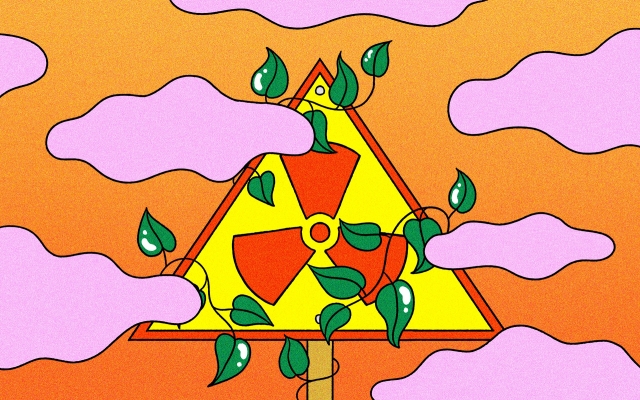Forest Fires Are Setting Chernobyl’s Radiation Free
Forest Fires Are Setting Chernobyl’s Radiation Free
12 серпня 2020 року
Story by Jane Braxton Little
10 August 2020

In the clear, calm, early hours of May 15, 2003, three miles west of the hulking ruins of the Chernobyl Nuclear Power Plant, Vasyl Yoschenko was bustling around a stand of Scotch pines planted 30 years earlier. The trees were spindly and closely spaced, but he was skinny enough to move easily among them, taking samples of biomass and litter. Just beyond the trees, he tinkered with the horizontal plates he had placed on the ground in a diagonal grid and covered with superfine cloth designed to absorb whatever came their way.
Yoschenko had just finished adjusting his monitoring equipment in the mid-afternoon when the first gusts of smoke billowed from the far side of the pines. Firefighters were torching the edges of an area the approximate size and shape of a football field. Wearing respirators, camouflage pants, and khaki shirts, cloth bandannas covering their heads, the men were systematically setting the woods ablaze. Flames leapt five feet up trunks, racing to the tops of some trees and sending plumes of smoke aloft.
Yoschenko, a Ukrainian radioecologist, had planned the controlled burn to study how radioactive particulates would behave in a fire, and he knew about the risks represented by the nuclear contamination swirling overhead. He prudently scooted to the edge of the forest, donned a gas mask, and began taking photographs. Was it dangerous? Yoschenko shrugs: “Not so much. We were lucky the wind didn’t change direction.”
The forest burned intensely for 90 minutes, releasing cesium-137, strontium-90, and plutonium-238, -239, and -240 in blasts of smoke and heat. In just one hour, the firefighters—and Yoschenko—could have been exposed to more than triple the annual radiation limit for Chernobyl’s nuclear workers.
“That was crazy,” says Sergiy Zibtsev, a forestry professor at the National University of Life and Environmental Sciences of Ukraine. “That place was really contaminated. Yoschenko risked his life to provide new science—just like Marie Curie.”
Read: Photos from the 1986 Chernobyl disaster
Yoschenko’s scientific blaze was a preview of Chernobyl’s future. Since then, the area’s climate has warmed and dried, and its wildfires—most sparked by arson and other human activity—have grown larger and more frequent. Each fire releases radionuclides, just as Yoschenko and his colleagues documented in 2003; each one raises anxieties in Kyiv, the Ukrainian capital, and in Europe’s major cities. But none has incinerated the landscape at the scale of the fires that burned this past April. They were far larger than any since the 1986 disaster, burning for weeks and scorching nearly 165,600 acres before rain finally doused them.
Monitors in Norway, 2,000 miles away, detected increased levels of cesium in the atmosphere. Kyiv was smothered in smoke. Press reports estimated that the level of radiation near the fires was 16 times higher than normal, but we may never know how much was actually released: Yoschenko, Zibtsev, and others impatient to take on-the-ground measurements were confined to their homes by the coronavirus pandemic. August is typically the worst month of the Chernobyl fire season, and this year, public anxiety is mounting. The devastation left by the world’s worst nuclear disaster is colliding with the disaster of climate change, and the consequences reach far and deep.
The Chernobyl Exclusion Zone is a rich mosaic of forests, grasslands, and bogs stretching 1,000 square miles across northern Ukraine. When I visited in 2013 I was shocked, like so many other visitors, by the abandoned family farmhouses with branches growing out of their empty windows, by painted silhouettes of children dancing on the walls of a community center in the hastily evacuated city of Pripyat, still haunted by their absence. But I also saw grasslands dotted with young pines, the wind wafting tawny heads of grains gone wild, and a white-tailed eagle soaring over the power plant cooling pond. In a grove of native birch trees, I stood in the morning light as it burnished the leaves against luminous white trunks. I was enchanted—until my dosimeter began chattering. Had I lingered there for an hour, I later realized, I would have been exposed to radiation levels 100 times beyond what’s considered safe for humans.
From Hiroshima, Chernobyl, and Fukushima, we are learning about the ghastly, lingering effects of radiation on human bodies. From the uninhabited landscapes of Chernobyl, we are learning how ecosystems react to—and recover from—the same invisible insult.
In the chaos after the April 26, 1986, disaster, Soviet officials worked frantically to contain the radiation spewing from the nuclear power plant’s No. 4 reactor. To protect public health, they evacuated an area nearly the size of Yosemite National Park. Since then, only those with permission are allowed into this exclusion zone, which Ukrainians aptly call the Zone of Alienation. Ukrainian law mandates that nothing—no blackberries, no mushrooms, no radionuclides—leaves the zone until the radiation dissipates, a long-term proposition, given the 24,000-year half-life of plutonium-239.
The unexpected result is an immense, long-term ecological laboratory. Within the exclusion zone, scientists are analyzing everything, including the health of the wolves and moose that
have wandered back and the effects of radiation on barn swallows, voles, and the microorganisms that decompose forest litter. Now, as wildfires worsen, scientists are trying to determine how these hard-hit ecosystems will respond to yet another unparalleled disruption.
Read: Visiting Chernobyl 32 years after the disaster
Chernobyl is not a landscape inclined to burn. The Vladimir Ilyich Lenin Nuclear Power Plant was built on the southwestern edge of the Pripyat Marshes, Europe’s largest swamp. For centuries, the watery terrain was all but impenetrable; floods made it impassable for months at a time, and bogs disoriented persistent invaders. The drier areas were forested with birch, aspen, other hardwoods, and some pines. Late in the 19th century, these forests were cleared for intensive agriculture. But even the most enterprising farmers struggled to grow wheat and other crops in the gravelly, sandy soil.
After Ukraine became part of the Soviet Union in 1922, the government returned the land to forests, logging them for fuel to produce glass and vodka. But instead of the natural mix of species, Soviet foresters planted row after evenly spaced row of Scotch pines, creating a giant softwood production area in a highly regulated forest. By the 1950s, these regularly logged pine plantations covered 400 square miles of what is now the Chernobyl Exclusion Zone.
The explosions that wracked the nuclear power plant in 1986 transformed all life in the region, human and otherwise. Thirty-one people died as an immediate effect of the explosions, and as many as 150,000 have since died of radiation exposure in Ukraine alone. Conservative estimates predict that the death toll will grow by another 41,000; other estimates exceed 1 million. And the disaster upended the lives of those who survived: The mandatory evacuation of 350,000 people forced residents of Pripyat to leave their newly built city, farmers to abandon their fields, and loggers to find work elsewhere.
The forest hit hardest by the nuclear blasts was a pine plantation that stood directly in the path of the most deadly debris. Pines are extremely sensitive to radiation, and the trees turned rust-orange before they died; workers nicknamed the plantation the “Red Forest.” As part of the effort to contain the radioactive material, they bulldozed it, buried the trees in more than 5 million square yards of topsoil, and covered the area with more than a foot of sand. Then they replanted it with pines. As the new trees grew, radiation in the soil suppressed an enzyme that contributes to the classic single-stem conifer shape, resulting in an expanse of odd-looking, bushy dwarf pines.
The rest of the forests in the exclusion zone were simply abandoned. Management stopped, leaving the heavily industrialized forests to evolve in their own way at their own pace. Pines began creeping into less contaminated farmland. Birches and other native species less sensitive to radiation began colonizing the hotter areas, slowly replacing the Scotch pines so favored by Soviet foresters. Before the explosion of Chernobyl’s nuclear reactor, forests covered about 30 percent of the exclusion zone; they now cover about 70 percent.
Less than two months after the disaster, Soviet officials launched a research institution designed to study the effects of irradiation on agriculture and ecology. Renamed the Ukrainian Institute of Agricultural Radiology in 1991 after the breakup of the Soviet Union, much of the information we have about contaminated foods and the dynamics of radionuclides has been developed here. When I arrived in 2012 at the institute, located in a
suburb southwest of Kyiv, I was ushered through an imposing rotunda, where loose tiles in the beautifully ornate floor provided a percussive accompaniment as I clicked and clacked across it. Vasyl Yoschenko, then 47, was waiting in a conference room, pacing around a long table and fidgeting with his glasses. He has a thick shock of intensely white hair and a wandering left eye, which give him a slightly reckless look.
In the spring of 1986, Yoschenko was a soldier in the Soviet Army, stationed 60 miles east of Moscow “for protection against the United States, of course,” he told me with an ironic grin. When his service ended a month after the disaster, he was excited to return to Kyiv: “It is a beautiful city, especially in spring, so just imagine what I was feeling after two years of military service.” Instead, he found an empty city. The only people on the streets were those employed to wash them down. Yoschenko resumed his education, completing a master’s degree in 1989 and immediately going to work at the radiology institute. Now armed with a doctorate, he carried at the time the unwieldy title of head of the laboratory of radioecological monitoring, mathematical modeling and dosimetry. He simplified it for me: “I study radiation.”
Read: California’s wildfires are 500 percent larger due to climate change
One of the institute’s most important early tasks was to estimate the concentrations of radionuclides in the soil throughout the exclusion zone. In the conference room, Yoschenko pointed to two framed documents covered with polygons of colors ranging from pale green to screaming orange. Made in 1997 and 2000, these are the first maps to chart the deposits of strontium, plutonium, and other radionuclides that rained down during the disaster. With Yoschenko and others, the institute head Valery Kashparov found that two-thirds of some of the contaminants and almost all the plutonium and strontium have been retained in Ukrainian soil. That was a surprise to some scientists, who had assumed that the radionuclides would move quickly into the water table or scatter around the world in the volatile winds generated by the explosions. Instead, as much as 96 percent of radionuclide activity was confined to the top 10 centimeters of soil.
Over the past 30 years, the government has largely succeeded at keeping what’s in Chernobyl in Chernobyl. But the radionuclides aren’t contained by Ukraine’s quixotic law forbidding their movement. They’re contained by functioning ecosystems.
The gases and debris blasted out of the nuclear power plant fell on trees, grasses, other plants, and fungi, coating them with radionuclides; as much as 90 percent of the contamination was captured in the canopies of pines and other conifers. When their needles fell to the ground, they became part of the forest litter, slowly dispersing the radionuclides they carried into the top layer of soil. Within several years, the trees began taking up these radioactive elements; because cesium and strontium are the chemical analogues of potassium and calcium, Yoschenko and his colleagues studied how the unsuspecting trees treated them as nutrients, absorbing them into their roots and moving them into their trunks. Over time, cesium and strontium accumulate in the trees’ needles, which again fall to the ground and become part of the forest litter.
Without trees or other permanent ground cover, Chernobyl’s radionuclides would have been carried out of the zone by wind or water. By sucking up the nuclear leftovers strewn across the landscape, the forests are stabilizing the contamination, helping prevent the spread of radionuclides south to Kyiv and northwest to Europe.
The forests’ astonishing ability to both survive and contain radiation is now threatened by the worsening wildfires, exacerbated by climate change. “Forests are our friend in health, our enemy when they burn,” says Zibtsev, the forestry professor. When Chernobyl’s trees burn, they send their stored radionuclides aloft as inhalable aerosols. Instead of blasting from a single source, as it did in 1986, the contamination now comes from the trees that cover some 660 square miles around the nuclear power plant.
Twenty-five years after the disaster, Zibtsev and others predicted that if the forests in the exclusion zone were completely consumed by fire, residents in Kyiv would face an increased risk of dying from cancer and government bans would need to be imposed on foods produced as far as 90 miles away. Although such a large and intense fire is currently unlikely, recent fires have been sizable enough to create similar problems. “If Chernobyl forests burn, contaminants will migrate outside the immediate area,” says Zibtsev. “We know that.”
Zibtsev, 59, is lean and lanky, with a heavy gray crew cut that always seems fully grown out. His father, a teacher, spent the summer of 1986 working outdoors, mostly in Kyiv. He developed cataracts that he suspected were caused by his radiation exposure, though they were never officially attributed to it. Two years later Zibtsev, whose doctorate in forest ecology is from Dnipro State University, had an opportunity to do research in the irradiated forests. His parents, afraid for his safety, refused to allow it. “They didn’t think I needed to risk my health over researching the migration of radionuclides in temporary waste-storage sites,” he told me.
His career stopped. “You don’t turn down a good opportunity like this, but I did,” he said. Instead, he mapped contamination in forests 150 miles west of the No. 4 reactor, where, ironically, the random patterns of radiation release deposited radionuclides that exposed him to the danger he was trying to avoid. Another offer to monitor Chernobyl forests came in 1993, and this time Zibtsev took it. He spent the next five summers collecting soil and vegetation samples that were later analyzed for traces of radionuclides. The radiation he found there was higher than it had been in the period immediately following the explosions, a surprising observation until Yoschenko’s 2003 experimental burn explained it: Fires had burned 12,500 acres in 1992, ripping through the crowns of trees and depositing hot ashes across the exclusion zone in the first out-of-control blaze since the disaster.
Read: The forest service is about to set a giant forest fire—on purpose
Zibtsev was on a Fulbright scholarship to Yale University in 2005 when he learned about catastrophic wildland fires in the western United States. “What if that happened here?” he wondered. “More than Ukraine would be affected.” Zibtsev started drumming up international interest in fire and radioactive safety. Not only Chernobyl firefighters but “distant populations” in other countries were at risk, he told an international conference in 2007. He began coordinating projects aimed at improving wildfire-management capacities through the Regional Eastern Europe Fire Monitoring Center, which he established in 2013 under the umbrella of the Global Fire Monitoring Center and the Council of Europe.
In 2015, a rash of fires in Chernobyl brought international attention to their dangers. By that time, the abandoned forests had filled with flammable dead trees, and when farmers just outside the zone set their fields ablaze—a time-honored agricultural practice—the nearby stands quickly caught fire. From April to August, 37,066 acres burned within the exclusion zone. Zibtsev and his colleagues later reported that radiation releases in the zone during the
fires were nearly 10 times normal levels, and that radiation levels in the forests of Chernobyl and Belarus nearly doubled in 2015.
Alarmed by the potential for fire-borne radiation releases over Europe, international concern focused on the sorry state of the firefighting forces assembled in Chernobyl. In the exclusion zone, firefighters monitor smoke from rickety lookout towers built before the 1986 disaster. Access roads are deteriorating and often blocked by downed trees. Though Zibtsev helped design a system of fuel breaks creating gaps in the vegetation, the large majority have never been built. The situation is worsened by an almost complete lack of coordination among the three agencies with jurisdiction in the exclusion zone. Faced with government instability, economic chaos, and a six-year war with Russia, Zibtsev said, Ukrainian officials do not have the energy, financial resources, or political will to concentrate on fires in Chernobyl.
During my 2012 visit, the firefighter Nikolay Ossienko showed me around the Paryshev Fire Station near the Belarus border, one of seven stations in the exclusion zone. A fleet of well-polished but aging four-by-four fire trucks was parked in a shed next to the wooden building that serves as the station’s office. Dominating the compound was an imposing Soviet-built tank, modified with a pointed plow blade. It’s used to create fuel breaks by crushing trees and brush—“anything,” explained Ossienko, a burly, blue-eyed Ukrainian whose warm smile winked with a missing tooth. Though firefighters like Ossienko maintain their equipment admirably, says Zibtsev, most of their vehicles are at least 20 years old and no longer reliable. During the April fires, many of them broke down, forcing firefighters to evacuate.
In recent years, a U.S. Forest Service project has installed five fire-detection cameras within the exclusion zone, provided protective gear and breathing devices to Chernobyl firefighters, and developed a fire-management plan to coordinate fire-suppression efforts. It’s very helpful, Zibtsev said, but it hasn’t solved the equipment shortage. In April, camera traps, which the University of South Carolina professor Timothy Mousseau had set up to monitor wildlife, photographed men fighting fire with wet rags. “No shirts, no masks, no gloves, just wandering around in a burning fire trying to tamp it out,” he told me.
This April’s fires, which scorched 23 percent of the exclusion zone, were the largest burns ever recorded in the area, nearly four and a half times the size of fires in 2015. Flames torched trees less than three miles from the ruined nuclear reactor, which is now enclosed by an arch-shaped steel shroud.
Although the fires expose Chernobyl’s firefighters to dangerous levels of radiation, their risks to residents of the region and beyond are so far relatively low. But as Zibtsev pointed out, individual health is a combination of many factors—food, water, quality of life—and any increase in radiation exposure, however small, adds to existing stresses. In his office, as he ticked off various threats to human health, he moved a small box around on the desktop in front of him, closer and closer to the edge. When he got to radiation, it tottered, ready to fall onto his lap. “Too many stressors hasten death,” he said.
Fire also imposes one more stress on Chernobyl’s ecosystems, a decidedly human wrench thrown into their long recovery from nuclear disaster. Induced by climate change and sparked by human activity, fire here is only slightly more natural than radiation. Persistent and widespread fire may destroy soil organics and radically redistribute the accumulated radionuclides, Yoschenko said, altering soil chemistry. Changes in soil chemistry will alter plants, which in turn will affect the food chain and animals dependent on it. And larger, more
intense fires could destroy the forests entirely, obliterating their ability to keep what’s in Chernobyl in Chernobyl. “Keeping forests healthy is the main ingredient to preventing the migration of radionuclides outside the zone,” Zibtsev told me.
For now, Chernobyl’s forests and grasslands are continuing to process cesium, strontium, and other radionuclides. Even the roots of the contorted trees in the Red Forest are taking up radionuclides, holding and stabilizing them in an ecosystem’s gift to the humans who created these contaminants. That process promises to continue—at least until the August fire season gets underway.
Jane Braxton Little is a freelance
writer based in California’s northern Sierra Nevada.
Her work has appeared in publications that include
Audubon, Discover, EHP, National Geographic,
and Scientific American.









